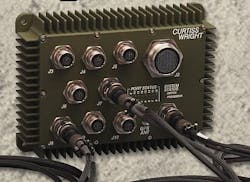Rugged Digital Beachhead vetronics networking device introduced by Curtiss-Wright
ASHBURN, Va., 25 Sept. 2012. Curtiss-Wright Controls Defense Solutions in Ashburn, Va., is introducing a rugged vetronics networking appliance for armored combat vehicles that is designed to be small, lightweight, power-efficient, and complies to the U.S. Army's Vehicular Integration for C4ISR/EW Interoperability (VICTORY) standard, which seeks to move Army vehicle design from a bolt-on integration approach towards network-centric, systems-oriented design.
The VICTORY architecture-based vetronics networking device from Curtiss-Wright is called Digital Beachhead, designed to add a rugged networking backbone to new and old military ground vehicles. Digital Beachhead combines a 16-port Gigabit Ethernet network switch with a vehicle management computer based on the ARM dual-core automotive processor.
Digital Beachhead measures 10 by 7 by 3 inches and weighs four pounds. It comes with vehicle management framework software for vehicle management and pre-integrated VICTORY services in harsh military environments. The unit costs about $5,000, Curtiss-Wright officials say.
The vetronics networking system enables combat vehicle systems integrators to integrate a modern vehicle control system not only into new vehicles, but also into relatively old ground vehicles like humvees that previously had no embedded on-board electronics, company officials say.
Digital Beachhead computer runs the vehicle’s health management (HUMS/CBM+) software as well as monitoring the vehicle’s primary systems, and comes pre-installed with Curtiss-Wrights Vehicle Management Framework (VMF) software that defines vehicle operations for use by the CBM+ and other in-system vehicle management services.
The Army’s VICTORY architecture encourages the use of COTS open-system standards to reduce redundancy and make additional space available. Curtiss-Wright officials say they plan to introduce variants of Digital Beachhead that support other localized standards such as the United Kingdom Generic Vehicle Architecture (GVA) with Data Distribution System (DDS).
"By leveraging adjacent market technologies, such as ARM processors from the automotive industry and low-power network switches designed for cell towers, we have met the Army’s challenge to deliver a radically affordable high performance Digital Backbone in a single, lightweight rugged package, says Lynn Bamford, senior vice president and general manager of Curtiss-Wright Controls Defense Solutions.
Features include rugged 16-port Ethernet network switch; 16 ports of tri-speed 10/100/1000Base-T Ethernet; Layer-2 managed switch for VLANs, QoS, Multicast, Spanning Trees, and Link Aggregation; IEEE-1588/PTP Precision Time Protocol for network synchronized time; in-band and out-of-band management, including HTTP/Web, CLI and SNMP support; and VICTORY/GVA dual-port 38999 rugged Ethernet connectors.
Digital Beachhead also has a locally connected GPS receiver to provide time and position information to all VICTORY enabled network nodes, supports VICTORY Automotive System Bus interfaces, and has a built-in inertial measurement unit.
The Digital Beachhead vehicle management computer provides logical access to common vehicle interfaces such as CANbus, analog, and digital I/O, camera, and audio.
The unit also interfaces with HUMS logistic services such as CBM+/CLOE and DDS, includes an event-driven framework for vetronics control and status, offers local user interface via VGA/DVI and USB keyboard/mouse; and has remote GUI via Web services.
The vetronics networking appliance has convection cooling, consumes 30 Watts of power, uses a MIL-STD-1275 28-volt DC power supply with optional nuclear event detector (NED), and meets MIL-STD-810 and MIL-STD-461.
For more information contact Curtiss-Wright Defense Solutions online at www.cwcdefense.com.
Follow Military & Aerospace Electronics and Avionics Intelligence news updates on Twitter

